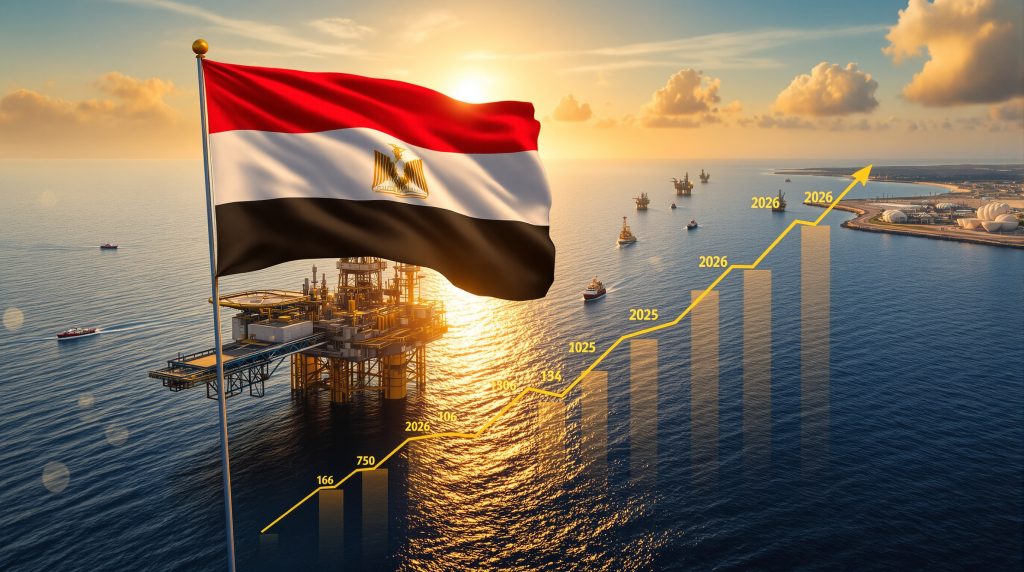Why Is Egypt Investing Billions in Oil Exploration?
Egypt is making a bold $6 billion investment in crude oil and natural gas exploration to reverse years of declining production and reduce its dependence on energy imports. This strategic initiative aims to strengthen Egypt's position as a regional energy hub amid growing domestic demands and economic pressures.
The ambitious five-year plan involves drilling 480 new exploratory wells across Egypt's key production regions, with 101 wells scheduled for 2026 alone. This represents one of Egypt's largest commitments to its hydrocarbon sector in recent years and signals a significant pivot in its energy strategy.
Egypt's Current Energy Landscape: Challenges and Opportunities
The Decline in Production and Its Economic Impact
Egypt's oil production has fallen significantly over the past two decades, declining from peak levels of approximately 922,000 barrels per day in 1993 to around 530,000-540,000 barrels per day currently. According to the U.S. Energy Information Administration's Egypt Country Analysis Brief, this steady decrease has forced the country to increase imports, straining foreign currency reserves and contributing to economic instability.
The nation has experienced periodic energy shortages, including rolling blackouts during peak demand periods in 2024, primarily due to natural gas price trends. These disruptions have affected both residential consumers and industrial operations, highlighting the urgent need for increased domestic production capacity.
Strategic Importance of Energy Self-Sufficiency
Egypt's geographic position at the crossroads of Africa, Europe, and the Middle East makes energy self-sufficiency particularly valuable. The country operates two crucial maritime passages—the Suez Canal, which handles approximately 12-15% of global trade, and the SUMED pipeline with a capacity of 2.5 million barrels per day—both serving as vital conduits for global energy transportation.
By boosting domestic production, Egypt aims to:
- Reduce its import bill and preserve foreign currency reserves
- Enhance energy security and reliability
- Create thousands of direct and indirect jobs
- Generate additional revenue through potential exports
- Strengthen its geopolitical standing in the region
The $6 Billion Investment Plan: Breaking Down the Numbers
Geographic Distribution of Exploratory Wells
The 480 planned wells will be strategically distributed across Egypt's four primary production regions:
| Region | Percentage of New Wells | Key Characteristics |
|---|---|---|
| Western Desert | 45% | Onshore, mature fields with remaining potential |
| Mediterranean Sea | 30% | Offshore, high potential for natural gas discoveries |
| Gulf of Suez | 15% | Mature offshore oil province with redevelopment opportunities |
| Nile Delta | 10% | Primarily gas-prone with some condensate potential |
Timeline and Investment Schedule
The $6 billion investment will be phased over five years, with increasing activity levels projected as the program advances:
- 2026: 101 wells ($1.2 billion)
- 2027: 110 wells ($1.3 billion)
- 2028: 115 wells ($1.4 billion)
- 2029: 120 wells ($1.5 billion)
- 2030: 34 wells ($0.6 billion)
Expected Production Impact
Government projections suggest successful implementation of this drilling campaign could:
- Add up to 150,000 barrels per day of new oil production
- Increase natural gas output by approximately 1.5 billion cubic feet per day
- Extend the production life of existing fields by 10-15 years
- Potentially discover entirely new petroleum systems
International Partnerships Driving Egypt's Energy Renaissance
Major Players and Their Commitments
Egypt has secured partnerships with several international oil companies to support its ambitious drilling program:
- BP: Has significant presence in Egypt's gas sector, particularly in offshore developments
- Eni: Expanding operations following its successful development of the giant Zohr gas field, which transformed Egypt's gas outlook
- Shell: Continuing exploration in the Western Desert and offshore areas
- Apache Corporation: Major operator in the Western Desert region
- ExxonMobil: Recently entered the market with exploration licenses in the Mediterranean
The success of the Zohr gas field, discovered by Eni in 2015, exemplifies the potential of these partnerships. With estimated reserves of 30 trillion cubic feet, Zohr began production in December 2017 and has helped transform Egypt from a gas importer back to a potential exporter.
Technology Transfer and Local Capacity Building
These international partnerships bring more than just capital—they provide access to cutting-edge exploration and production technologies:
- Advanced seismic imaging techniques for better subsurface visualization
- 3D and 4D seismic surveys to identify remaining reserves in mature fields
- Horizontal drilling technology to improve recovery rates
- Enhanced recovery methods to maximize output from mature fields
- Training programs for Egyptian engineers and technicians
Beyond Crude: Egypt's Broader Energy Strategy
The New Alamein Petrochemicals Complex
Complementing its upstream investments, Egypt is developing a major petrochemicals complex in New Alamein. This facility will:
- Process domestically produced hydrocarbons into higher-value products
- Create thousands of skilled jobs
- Reduce imports of petrochemical products
- Generate export revenue from finished products
Renewable Energy Integration
While doubling down on hydrocarbon development, Egypt is simultaneously advancing renewable energy projects:
- The Benban Solar Park: Located in Aswan Governorate with a total capacity of 1.65-1.8 GW, comprising multiple plants spanning approximately 37 square kilometers, making it one of the largest solar installations in Africa
- Wind farms along the Red Sea coast: Utilizing Egypt's substantial wind resources, with operations since the 2000s
- Green hydrogen initiatives: Multiple memoranda of understanding signed with European and international companies for projects planned in areas including Ain Sokhna and the Suez Canal Economic Zone
This balanced approach aims to optimize Egypt's diverse energy resources while gradually transitioning to a more sustainable energy mix, with a target of 42% of electricity from renewables by 2030 according to Egypt Vision 2030 documents.
Economic Implications of Egypt's Oil Investment
Impact on Government Finances
Successful implementation of the drilling program could significantly improve Egypt's fiscal position:
- Reduced energy import costs
- Increased tax and royalty revenues from new production
- Potential foreign currency earnings from exports if production exceeds domestic needs
- Improved sovereign credit ratings as energy security strengthens
Egypt's foreign currency reserves have been under pressure in recent years, requiring IMF support programs, including an $8 billion Extended Fund Facility approved in March 2024.
Employment and Economic Multiplier Effects
The investment is expected to create substantial employment opportunities in the oil and gas sector and supporting industries. The Egyptian petroleum sector already serves as a significant contributor to the country's GDP, with the Egyptian General Petroleum Corporation (EGPC) managing the upstream sector as the state-owned entity.
Challenges and Risks to Egypt's Oil Strategy
Geopolitical Uncertainties
Egypt's energy development plans face several external challenges:
- Regional security concerns affecting investment confidence, including increased Red Sea security issues since late 2023 with Houthi attacks on shipping
- Competition from other producing countries for limited exploration capital
- Fluctuating oil price rally dynamics impacting project economics
- Potential sanctions or trade restrictions affecting technology access
Environmental Considerations
The expansion of oil and gas activities raises environmental questions:
- Potential impacts on Mediterranean marine ecosystems, with offshore drilling raising concerns for a region protected under the Barcelona Convention
- Water usage concerns in the desert regions
- Greenhouse gas emissions and climate commitments, particularly relevant after Egypt hosted COP27 in Sharm El-Sheikh in 2022
- Regulatory compliance and international environmental standards
Financing Risks
Securing the full $6 billion investment faces potential obstacles:
- Dependency on continued foreign direct investment
- Competition for capital with renewable energy projects
- Sensitivity to global interest rates and investment climate
- Need for stable regulatory and fiscal terms
Egypt has faced currency devaluation challenges in recent years, with multiple IMF programs reflecting ongoing macroeconomic pressures.
How Will Success Be Measured?
Key Performance Indicators
The success of the exploration program will likely be measured against industry standards:
- Exploration success rates (typically ranging from 10-40% depending on basin maturity)
- Cost per barrel of new reserves added
- Production decline rate mitigation in mature fields
- Foreign investment attracted to the energy sector
- Reduction in energy imports as a percentage of consumption
Long-term Strategic Objectives
Beyond immediate production gains, Egypt aims to achieve:
- Establishment as a regional energy hub for the Eastern Mediterranean
- Development of a robust domestic service and equipment manufacturing sector
- Creation of sustainable employment in the energy sector
- Enhanced energy security and reduced vulnerability to external shocks
Egypt's Energy Gamble: A Balanced Approach
Egypt's $6 billion investment in oil and gas exploration represents a calculated bet on the continued importance of hydrocarbons to its economic future. While many countries are pivoting exclusively toward renewable energy, Egypt is pursuing a hybrid strategy that seeks to maximize the value of its existing natural resources while gradually building renewable capacity.
The success of this ambitious drilling program will depend on multiple factors, including global energy prices, exploration success rates, and the ability to attract and retain international partners. If successful, it could transform Egypt's energy outlook, strengthen its economy, and enhance its regional influence.
However, the risks are substantial, and the investment comes at a time of global energy transition. Egypt faces competition from other Eastern Mediterranean countries, including Israel, Cyprus, and Lebanon, which are developing their own offshore gas resources and creating a competitive regional LNG export market.
According to the OPEC's global oil influence and recent OPEC meeting impact, developing nations will likely continue to see oil demand growth despite global transition policies. Furthermore, current oil price stagnation analysis suggests Egypt's balanced approach—investing in both hydrocarbon development and renewable energy—may provide a pragmatic path forward for meeting growing energy demands while working toward long-term sustainability goals.
Disclaimer: This article contains projections and forecasts about Egypt's energy sector development. These projections are based on currently available information and are subject to change as new information becomes available or as market conditions evolve.
Want to Spot Major ASX Mining Discoveries Before the Crowd?
Discover how significant mineral finds can generate substantial market returns with Discovery Alert's proprietary Discovery IQ model, which transforms complex data into actionable insights for both short-term traders and long-term investors. Explore historic examples of exceptional investment outcomes by visiting Discovery Alert's dedicated discoveries page.




